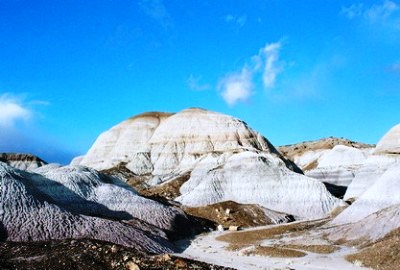
The sun was slowly setting over the Petrified Forest, giant slabs of ancient wood and mountains of white bentonite alternately catching fire and fading into shadow. Driving north on Highway 77, the miles ticked past in streams of rusty barbed wire and broken cars.
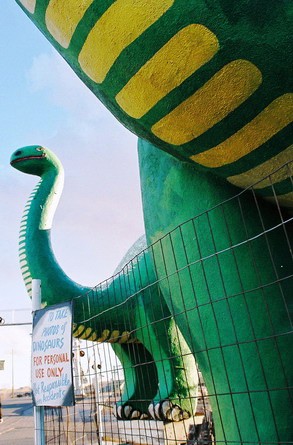 Millions of glass shards, jagged jewels marking decades of speeding drunks tossing liquid dreams out car windows, glittered from the shoulder of the road and twinkled in the dry yellow grass. Just south of a set of railroad tracks the highway became Navajo Blvd. before intersecting Bucket of Blood St. We stopped the car in the shadow of several tall green dinosaurs. Across the street in one direction was an abandoned tack shop built in the 1920’s. In another direction stood a boarded up wreck of a building made entirely of polished petrified wood. Holbrook (or T’iisyaakin in Navajo), Arizona was suddenly looking like a damned interesting place to spend the night.
Millions of glass shards, jagged jewels marking decades of speeding drunks tossing liquid dreams out car windows, glittered from the shoulder of the road and twinkled in the dry yellow grass. Just south of a set of railroad tracks the highway became Navajo Blvd. before intersecting Bucket of Blood St. We stopped the car in the shadow of several tall green dinosaurs. Across the street in one direction was an abandoned tack shop built in the 1920’s. In another direction stood a boarded up wreck of a building made entirely of polished petrified wood. Holbrook (or T’iisyaakin in Navajo), Arizona was suddenly looking like a damned interesting place to spend the night. 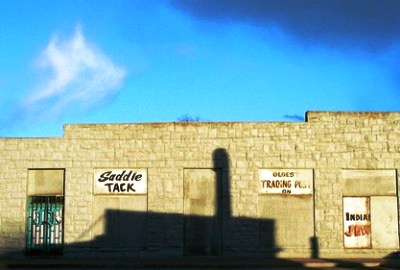
In 1881 (or possibly 1882, there appears to be some dispute), Holbrook, named after the first chief engineer of the Atlantic and Pacific Railroad, was born and immediately became a place to practice the holy trinity of Wild West pursuits: gambling, prostitution and gun fighting. It soon became known as a town “too tough for women or churches.” There was virtually no law in Holbrook and the violence ranged from Apache and Navajo raids on settlers to the Pleasant Valley War, which pitted a family of sheep ranchers against a family of cattle ranchers and lasted ten years, leaving a trail of bodies in its wake.
In 1886, the population of Holbrook was about 250 and 26 people died violent deaths, making a citizen's likelihood of being murdered that year something over 1 in 10. Some of the outlaw cowboys in Holbrook were members of the Aztec Cattle Company and worked for the Hashknife Outfit. These cowboys were involved in the Pleasant Valley War, stole cattle, and shot their guns quite a bit. They were known as the “thievinist, fightinist bunch of cowboys in the west."
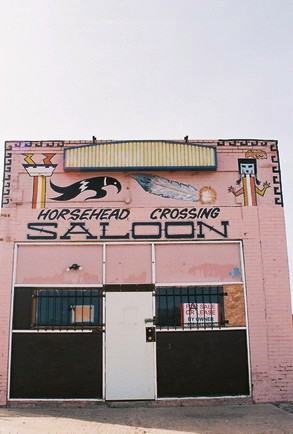 The main saloon in Holbrook was, of course, the site of much violence, and had the bucolic name Perkins' Cottage Saloon. There are two stories as to why the saloon changed its name that year. The first has some of the boys of the Hashknife Outfit accused of stealing cattle while having a drink. A brutal shoot-out is said to have ensued, leaving numerous patrons dead. The second story, told by Albert F. Potter, captain of the Hashknife's round-up, depicts two Mexican cowboys being shot during a card game by a gambler and a Hashknife Outfit cowboy. The gambler and cowboy quickly rode away on "borrowed" horses. Whichever story is true, it was written that after the incident “buckets of blood” covered the floor of the saloon. Thus the owners decided to change the name of their establishment to better match its disposition. This photo is clearly not of the Bucket of Blood, but it is on the same street.
The main saloon in Holbrook was, of course, the site of much violence, and had the bucolic name Perkins' Cottage Saloon. There are two stories as to why the saloon changed its name that year. The first has some of the boys of the Hashknife Outfit accused of stealing cattle while having a drink. A brutal shoot-out is said to have ensued, leaving numerous patrons dead. The second story, told by Albert F. Potter, captain of the Hashknife's round-up, depicts two Mexican cowboys being shot during a card game by a gambler and a Hashknife Outfit cowboy. The gambler and cowboy quickly rode away on "borrowed" horses. Whichever story is true, it was written that after the incident “buckets of blood” covered the floor of the saloon. Thus the owners decided to change the name of their establishment to better match its disposition. This photo is clearly not of the Bucket of Blood, but it is on the same street.Over 120 years after its construction, the Bucket of Blood Saloon still stands. You would think that its longevity would ensure that most residents of Holbrook would know its location.
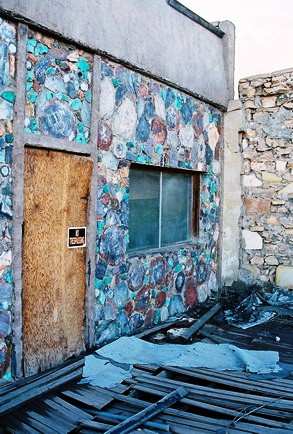 Clearly, it’s got to be somewhere on Bucket of Blood St. Yet some locals directed us to the wrong place, telling us that this building made of petrified wood was once the Bucket of Blood Saloon. While a fascinating building in its own right, and probably also a saloon at one time, this was never the Bucket of Blood. The Bucket of Blood is not far away though and I found it somewhat by accident. Not realizing I’d been standing in front of the place until later, the photo below mostly depicts the Bucket of Blood’s neighbor. The Bucket of Blood itself is just to the left, the far-right bit of its lintel just creeping into the frame. I hope to return soon and explore further, now that I’d know what infamy I was looking at.
Clearly, it’s got to be somewhere on Bucket of Blood St. Yet some locals directed us to the wrong place, telling us that this building made of petrified wood was once the Bucket of Blood Saloon. While a fascinating building in its own right, and probably also a saloon at one time, this was never the Bucket of Blood. The Bucket of Blood is not far away though and I found it somewhat by accident. Not realizing I’d been standing in front of the place until later, the photo below mostly depicts the Bucket of Blood’s neighbor. The Bucket of Blood itself is just to the left, the far-right bit of its lintel just creeping into the frame. I hope to return soon and explore further, now that I’d know what infamy I was looking at. 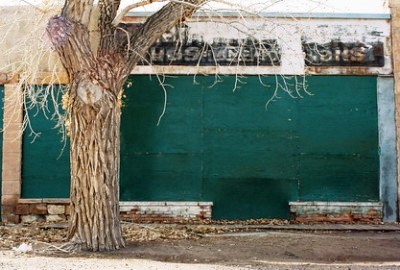
The year after the shoot-out at the Bucket of Blood Saloon, on September 4, 1887, Commodore Perry Owens, the sheriff of Holbrook, dubbed "Saint George with a six-shooter," made it known that law and order had finally come to the territory. While serving a warrant on notorious rustler Andy Cooper at the home of the Blevins Gang, the outlaw tried to close the door on the sheriff. Owens fired through the door with his shotgun, hitting Cooper in the stomach. John Blevins returned fire but shot Cooper's horse instead and was himself shot in the arm. Another man, Mose Roberts, jumped out a window and was killed by Owens. Finally, Samuel Houston Blevins, Cooper's 15-year-old brother, came out the door and ran at the sheriff pointing his dying brother's pistol. Owens shot and the boy died in his mother's arms. In less than a minute the gunfight was over and the back of Holbrook's cattle rustlers had been broken. Owens, now a legend, remained sheriff until 1896, nearly another ten years. The Blevins House still stands.
In 1895, Navajo County was created by the territorial legislature and Holbrook was designated the county seat.
 The county courthouse was built in 1898 and used as such for 78 years. There were many trials but only one man, George Smiley, convicted of murder, was ever executed. His hanging became notorious for an unusual reason. In the late 1800’s, Arizona law required that every sheriff in Arizona, as well as certain public officials, received an invitation to each execution scheduled to occur in the state. Commodore Perry Owens' successor, Sheriff Frank Wattron, could find no official format or template for such an invitation so he designed his own, complete with flowery language and a gilt-border. It read:
The county courthouse was built in 1898 and used as such for 78 years. There were many trials but only one man, George Smiley, convicted of murder, was ever executed. His hanging became notorious for an unusual reason. In the late 1800’s, Arizona law required that every sheriff in Arizona, as well as certain public officials, received an invitation to each execution scheduled to occur in the state. Commodore Perry Owens' successor, Sheriff Frank Wattron, could find no official format or template for such an invitation so he designed his own, complete with flowery language and a gilt-border. It read: “You are hereby cordially invited to attend the hanging of one George Smiley, murderer. His soul will be swung into eternity on December 8, 1899, at 3 o’clock p.m., sharp.
Latest improved methods in the art of scientific strangulation will be employed and everything possible will be done to make the surroundings cheerful and the execution a success.
F.J. Wattron, Sheriff of Navajo County.”
It sounded like quite an enjoyable afternoon, but President McKinley believed an execution demanded a certain amount of gravity and, when word of the invitation reached him, he contacted the Governor of Arizona to issue a stay of execution for 30 days and gave Sheriff Wattron a personal reprimand.
So, the sheriff set about writing another invitation. This time it read:
“Revised Statutes of Arizona, Penal Code, Title X, Section 1849, Page 807, makes it obligatory on sheriff to issue invitations to executions, form (unfortunately) not prescribed.
Holbrook, Arizona
Jan. 7, 1900.
With feelings of profound sorrow and regret, I hereby invite you to attend and witness the private, decent and humane execution of a human being; name, George Smiley, crime, murder.
The said George Smiley will be executed on Jan. 8, 1900, at 2 o’clock p.m.
You are expected to deport yourself in a respectful manner, and any ‘flippant’ or ‘unseemly’ language or conduct on your part will not be allowed. Conduct, on anyone’s part, bordering on ribaldry and tending to mar the solemnity of the occasion will not be tolerated.
F.J. Wattron, Sheriff of Navajo County.
I would suggest that a committee, consisting of Governor Murphy, Editors Dunbar, Randolph and Hull, wait on our next legislature and have a form of invitation to executions embodied in our laws."
To ensure the thinly-veiled sarcasm of this second invitation did not result in another letter from President McKinley, Sheriff Wattron sent the invitation out one day before the execution date. George Smiley swung before news of the second invitation ever reached Washington, D.C. and he now haunts the courthouse, perhaps waiting for another message from McKinley, one that will never come. The photo above and the one below are both from the jail in the old Navajo County Courthouse. The night of Wednesday, April 30, 1975 was not a good one in Holbrook.
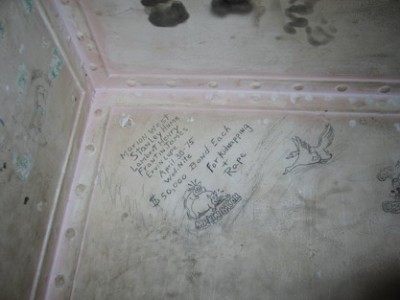
After reliving the brutality of American history, why not stay in a Wigwam for the night? Wigwam Motel #6 (there were once seven Wigwam Motels throughout the country; three survive) is on Hopi Dr., in central Holbrook. It was built in 1950 and is now on the National Register of Historic Places. Of course, a wigwam is a domed-structure and the “rooms” at the Wigwam Motel are more properly teepees. But why split hairs? There’s a vintage jalopy parked in front of each teepee and when the sun sets it’s not hard to imagine you’re in the real thing.
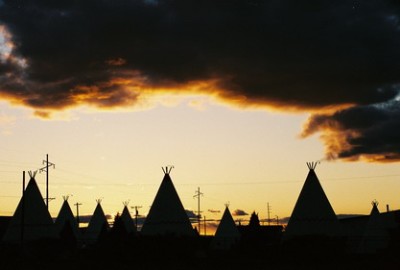
One last quick fact about Holbrook: On July 19, 1912, a 400 lbs. meteorite exploded over the town. It’s estimated that more than 16,000 stones fell out of the sky, some weighing almost 15 lbs. I guess danger takes a variety of forms in Holbrook.
There’s not too much on the web about Holbrook, but the sites I found most useful were one on the BUCKET OF BLOOD SALOON and another on the NAVAJO COUNTY COURTHOUSE. I also got some information from the Northeastern Arizona Daytrip Guide.
If you want to visit Holbrook and stay at the Wigwam Motel, their website is HERE.

The next post shouldn’t take long to get up—not months, at least. It’s going to be on the much less sordid but perhaps more tasty burg of Pietown, New Mexico.
2012 UPDATE: Below is a better picture of the Bucket of Blood Saloon (on the far left). Note the faded word "saloon" on the lintel. That's the entire rest of the block off to the right. Someone (rich) please open these buildings back up!
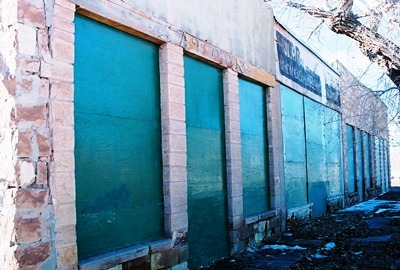
17 comments:
Interesting. I like your blog--I just happened on to it. I suppose you know there is another Bucket of Blood saloon in Virginia City, NV--I knew the former owner, he's now deceased. His daddy brought the old Capital Saloon in the early 30s and renamed it Bucket of Blood and they've done well with the boom of tourist that came along after the TV program Bonanza.
I was vaguely aware that there was another Bucket of Blood Saloon, but I didn't know it was in Virginia City, NV. Thanks for the information. There's also a Nick Cave & the Bad Seeds re-make of the old song Stagger Lee that has the protagonist going to "a place called the Bucket of Blood." So, I guess ol' Stagger must've gone to either NV or AZ...unless there's another one in Europe somewhere.
Thanks for stopping by and thanks for the kind words!
Best,
John
In this blog post from a couple of years ago, I have a picture of the north side of the Nevada "Bucket of Blood." I just realized they said, "original" but theirs wasn't named till the 1930s.
http://sagecoveredhills.blogspot.com/2008/07/hiking-around-virginia-city.html
Thanks for the link! it's cool to see a photo of the Virginia City Bucket of Blood Saloon. I see that the sign says "Since 1876." I take it the saloon was named something else prior to 1930. 1876 would give the Holbrook saloon a run for its money if the owner wanted to argue that the place is the same even if the name has changed. And, of course, the Holbrook Bucket of Blood isn't exactly serving at the moment. Nice post. Perhaps I'll get up to Virginia City sometime. I like that pinon/ponderosa landscape.
Hello JMHOUSE!
I am currently sitting in a shitty hotel in Holbrook and I came across your site! The lady friend and I are travelling across the USA and we are here for the night. Just wanted to thank you for shining a light on this mysterious little town. Will be visiting the Bucket of Blood tomorrow!
Joel
Hi Joel,
Thanks for the comment! I'm glad City of Dust shed a bit of light on Holbrook. The town has got a hell of a history. There's not much left of the Bucket of Blood, but, y'know, you can use your imagination. We're planning a return trip soon with a stop at the Wigwam Motel (Oprah found the wigwams "claustrophobic", I've been told. I bet I've slept on more floors then her though.)
Thanks again and enjoy your cross country trip. Stay south to avoid the blizzards!
John
The building a few up that says "Horsehead Crossing" Was until recent years called The Arizona Tavern. The Arizona Tavern has the oldest(longest) existing liquor license in the state of Arizona. It has survived numerous fires and If Im correct also had its share of eyebrow raising history. A "speak easy" in prohibition times with gambling also in the basement... To this day it has a huge old wood stove in the basement..
Thanks for the info on the Horsehead Tavern, billysmama. I didn't know much of that and, coincidentally, I was through Holbrook again just yesterday. I took a few photos of the Horsehead Tavern and could see the vague outline of "Arizona Tavern" at the top of the building. I paid another visit to the Bucket of Blood Saloon and even Dusty River Antiques was open, which I'd never seen before. I had a nice chat with the proprietor and learned that the building next door, made of petrified wood, used to be a souvenir shop. Another gentleman in the store mentioned that it had been closed since the 1950's. Apparently there is an effort--possibly small, I suppose--to restore the Bucket of Blood. That would be very cool.
Thanks again for your comment! JM
Very interesting stuff. Not to much to say, trying to figure out which Bucket of Blood was the wildest if you will; NV or AZ. And I'm a bit confused with the dates, they were both built before 1886...?
Luckily, we've got some sharp readers that have provided details on the difference between the two saloons. The Bucket of Blood in NV was established in 1876, but didn't go by that name until the early 1930's. Before that it was called the Capital Saloon. I've never visited this saloon--I only assume it's still in the original building--and don't know any stories of bloodshed offhand.
The Bucket of Blood in Holbrook was at first known as Perkins' Cottage Saloon. I don't know when it was established. It could have been 1881 or even earlier. But it's name was changed to the Bucket of Blood in 1886. The bloody goings-on that might have led to the name change are described above. In terms of wildness, the history of the AZ saloon might be tough for the NV one to top, I'd think.
Anyone have any stories about the NV Capital/Bucket of Blood?
I've been back to Holbrook since this post and have a better shot of the actual saloon building. I will try to post it here soon.
Thanks for your comments Dana! JM
While working, I came across a patient whose address was Bucket of Blood St.... I did not ask her for the background story, but immediately looked up the location. Which, lucky me, led to you! You are a wonderful writer & photographer. Thank you for exploring the places I wish I could!!!!
Wow. Were they from Arizona? There aren't many obvious residences along Bucket of Blood St., but there are some places that a person could theoretically live in. Very interesting.
Anyway, glad to be of service! Thanks for your kinds words. They're very much appreciated. JM
She was from AZ, and did apparently reside somewhere on that street... Google image did not make it look like a Particularly Residential Area, but hey, who am I to judge? ;) Keep up the good work, I'm officially a fan.
I was born in Holbrook in 1926 and lived there until I joined the Navy during World War II , love my little town of Holbrook especially the old courthouse and the stores such such as the Pay n Take it.
My uncle was a security guard at the petrified Forest and I was an altar boy for 10 years at the old Lady of Guadalupe. Once a year our church would go to the Hopi Indian reservation where we would baptize the Indians that wanted to be baptized surprisingly, most of Hopi's.
Thank you for your comment, Anonymous! I don't hear from too many people that were born and raised in Holbrook, so your memories are much appreciated. It must've been a fascinating place in the 1920's and 1930's, to say the least! Whereabouts was (is?) the Pay 'n Take It?
Thanks again! JM
The Pay-N-Takit was catty-Corner from the old Holbrook Courthouse and next door was the old J-C Penny store and down the block was our only little theater The Roxy. The little Colorado river ran right through Holbrook. The highlights of Holbrook.was the annual Rodeo. It was an old western jamboree.
Thank you for that peek into the Holbrook of yesteryear, Anonymous! I'm quite fond of Holbrook and love to hear anything I can about the town in the old days. Nothing like a good ol' fashioned western jamboree!
Thanks again! JM
Post a Comment